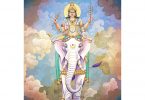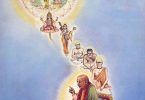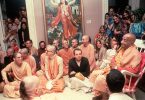Question: I would like to ask you a question regarding the talk between Ramananda Raya and Lord Caitanya. [CC Madhya 8.63-65]. Could you explain why Ramananda Raya says that the stage of brahma bhuta (Bg 18.54) is superior to the stage of surrender to Krishna (Bg 18.66)?
Answer by Romapada Swami :
In the context of this discussion with Lord Caitanya about the ultimate goal of life, Ramananda Raya is presenting different gradations or depths of spiritual consciousness. Thus, while studying these different verses quoted by Ramananda Raya, we should consider the inner consciousness of the performer represented by each stage, rather than the individual slokas by themselves as stand-alone principles.
When seen in this light, the varnasrama stage proposed first represents the consciousness of a common, materialistic man who abides by standard religious guidelines and formulas, for the sake of obtaining superior material enjoyment. The real interest of the performer here is one’s own ‘dharma-artha-kama-moksha’. Lord Caitanya rejected this as external, because although varnasrama dharma is supposed to be for the satisfaction of Vishnu, the performer usually has no real interest in Vishnu.
Above this is the stage of offering the result of whatever work one performs in the material world to Krishna. (yat karosi yad asnasi etc) Although there is a sense of sacrifice and devotion to God, the consciousness of such a person is mixed, and still materially absorbed. To transcend this material absorption, Ramananda Raya offers the stage of sarva-dharma-tyaga: “sarva-dharman parityajya”. In other words, he proposes renunciation of material activities as superior to the materially-attached position.
Please note that Ramananda Raya is NOT quoting “sarva-dharman parityajya” in the sense of complete surrender to Krishna. Krishna does speak this verse in that sense of total surrender being the perfection of renunciation. But this is not the context in which Ramananda Raya is presenting; he is merely advocating the position of “karma-tyaga” or “karma-sannyasa”.
One who genuinely renounces all material connection in this spirit, for the sake of spiritual advancement, is indeed pleasing to God. However, this principle can be easily misapplied by someone who externally renounces material life out of frustration, but without sufficient internal detachment and without real attachment to the Lord. As we know from Bhagavad-gita, Krishna does not approve of such irresponsible renunciation or karma-tyaga, as much as He recommends performing one’s duty with detachment. (BG 6.1-2, 3.4-8, 18.1-12 etc) Therefore, Sri Caitanya Mahaprabhu rejects this stage as external.
In comparison to external renunciation, the position of jnana-misra-bhakti is superior. The “brahma-bhuta” stage indicates being situated on a spiritual platform, where one is fully joyful, free from hankering and lamentation, and is equipoised towards all living entities — on this platform one can attain jnana-misra-bhakti. This stage is also external in relation to the ultimate goal of life, but it is superior to dry renunciation. The real beginning of pure spiritual consciousness is to go beyond this stage to the stage of submissive aural reception from saintly devotees – this was accepted by Sri Caitanya Mahaprabhu as the beginning of perfection.







